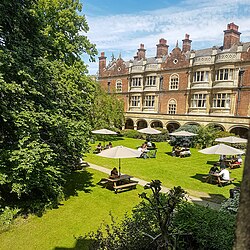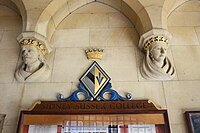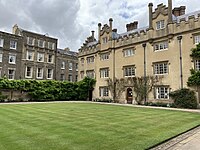Difference between revisions of "Sidney Sussex College, Cambridge"
(Created page with "{{Infobox college |name=Sidney Sussex College |county=Cambridgeshire |university=Cambridge |picture=Cloister Court, Sidney Sussex College.jpg |picture caption=Cloister Court,...") |
(No difference)
|
Latest revision as of 21:51, 12 April 2024
| Sidney Sussex College
| |||||
|
Dieu me garde de calomnie | |||||
|---|---|---|---|---|---|
 Cloister Court, Sidney Sussex College | |||||
| Master: | Martin Burton | ||||
| Website: | www.sid.cam.ac.uk | ||||
Sidney Sussex College scarf | |||||
| Location | |||||
| Grid reference: | TL45015868 | ||||
| Location: | 52°12’26"N, 0°7’15"E | ||||
Sidney Sussex College is a constituent college of the University of Cambridge. The College was founded in 1596 under the terms of the will of Frances Sidney, Countess of Sussex (1531–1589), wife of Thomas Radclyffe, 3rd Earl of Sussex, and named after its foundress. In her will, Lady Sidney left the sum of £5,000 together with some plate to found a new College at Cambridge University "to be called the Lady Frances Sidney Sussex College".[1] Her executors, Sir John Harington and Henry Grey, 6th Earl of Kent, supervised by Archbishop John Whitgift, founded the Protestant College seven years after her death.[2]
Contents
History
Foundation
Before Sidney's founding as a Protestant seminary, the site was home to the Grey Friars, or Franciscans, for nearly three centuries. In the 1950s, excavations revealed remnants of the complex, a lay graveyard with reburied skeletons, shattered stained glass, and a large Saxon jar. The mediæval cellars beneath Hall Court, where Sidney's wine is stored, are remnants of this era.[3]
The college was founded in 1596 under the terms of the will of Frances Sidney, Countess of Sussex (1531–1589), wife of Thomas Radclyffe, 3rd Earl of Sussex, and named after its foundress. It was from its inception an avowedly Protestant foundation;[2] "some good and godlie moniment for the mainteynance of good learninge". In her will, Lady Frances Sidney left the sum of £5,000 together with some plate to found a new college at Cambridge University "to be called the Lady Frances Sidney Sussex College".[4] Her executors Sir John Harington and Henry Grey, 6th Earl of Kent, supervised by Archbishop John Whitgift, founded the college seven years after her death.[2]
Expansion
While the college's geographic size has changed little since 1596, an additional range was added to the original E-shaped buildings in the early 17th century and the appearance of the whole college was changed significantly in the 1820s and 1830s, under the leadership of the master at the time, William Chafy. By the early 19th century, the buildings' original red brick was unfashionable and the hall range was suffering serious structural problems.
The opening up of coal mines on estates left to the college in the 18th century provided extra funds, which were to be devoted to providing a new mathematical library and accommodation for mathematical exhibitioners. Also with those funds, the exterior brick was covered with a layer of cement, the existing buildings were heightened slightly, and the architectural effect was also heightened, under the supervision of Sir Jeffry Wyatville.[5]
In the late nineteenth century, the college's finances received a further boost from the development of the resort of Cleethorpes on college land on the Lincolnshire coast. This land had been purchased in 1616, following a bequest for the benefit of scholars and fellows by Peter Blundell, a merchant from Tiverton, Devon.[6][7] A new wing (Cloister Court), added in 1891 to the designs of John Loughborough Pearson, is stylistically richer than the original buildings and has stone staircases, whereas the stairs in the older buildings are made of timber.[8]
In the early twentieth century, a High Church group among the fellows was instrumental in the rebuilding and enlargement of the chapel, which was provided with a richly carved interior in late seventeenth-century style, designed by T. H. Lyon, and somewhat at odds with the college's original Puritan ethos.[9]
Buildings and grounds
Sidney's buildings blend old and new, with the latest addition, the Old Kitchen (new dining space), completed in 2021. Sidney is the only college with a student-run bar. Student rooms have kitchen access, but also have catered options.[10]
Sidney sits on the site of Cambridge's Franciscan friary, built in the middle of the 13th century and dissolved in the 1530s. Artefacts of the site's past lie beneath the foundations of the college buildings.[11]
Sidney Sussex has two courtyards surrounded by Grade I listed buildings dating from 1596.[12]
Chapel Court
This court incorporates a number of buildings that house offices, the Junior Common Room (JCR) and a wood panelled chapel.
The Chapel, for which this court is named, has gone through many forms over the years. The current building was rebuilt in the 18th century, and has been extended a number of times in subsequent centuries. The exterior was entirely remodelled in 1833 to match the Gothic style of the rest of the buildings.
The carved interior of the Chapel was installed in the early 20th century to suit the High Church tastes of a group of college fellows.
The Chapel is open throughout the day as a space for the college community, regardless of faith or background.[13]
Hall Court
Hall Court is enclosed by a range of Gothic buildings incorporating the Master's Lodge, Buttery and the new Kitchen buildings, but the Court's name comes from Sidney's Dining Hall.[14]
The dining hall was redesigned by Sir James Burrough in 1752.[15] The hall had been in poor repair, and the 'elegant Rococo room' that emerged from the remodelling was seen as a way to attract students and Fellows. Sidney's Dining Hall features decorated plasterwork, pillars, and an elaborate rococo ceiling with a centrepiece of scrolls and acanthus foliage.[16]
A portrait of the college's founder, Lady Frances Sidney, Countess of Sussex, is mounted over the high table.[17]
The Hall is used for a whole range of functions for undergraduates, postgraduates, alumni and fellows, it is used to meet and socialise.
Cloister Court
Added in 1891 and designed in the Gothic revival style, these buildings recall the Franciscan roots of the site.[18]
The buildings house a number of student rooms, gardens and lawn, where a number of mediæval graves were uncovered.
Chapel and music
The old chapel, built by James Essex in the 1770s, was very small at 20 by 30 feet. The old bell, bought from Pembroke Hall in 1707 and recast in 1739, was retained until 1930 when it was replaced with a new one. The work to the new chapel was completed in 1923. The antechapel now contains wall memorials to the dead of the two world wars and to three masters, Parris, Elliston and Chafy. The presence of Oliver Cromwell's head, buried somewhere nearby, is marked by a tablet installed in 1960.
The Sidney Chapel includes a Steinway grand piano, a harpsichord, a chamber organ and a Flentrop organ.
Outside links
| ("Wikimedia Commons" has material about Sidney Sussex College, Cambridge) |
References
- ↑ Hearn, Karen, ed. Dynasties: Painting in Tudor and Jacobean England 1530–1630, p. 95
- ↑ 2.0 2.1 2.2 Sidney Sussex College history
- ↑ "College history" (in en). https://www.sid.cam.ac.uk/about-sidney/college-history.
- ↑ Hearn, Karen, ed. Dynasties: Painting in Tudor and Jacobean England 1530–1630, p. 95
- ↑ Peter Salt, 'Wyatville's remodelling and refurbishment of Sidney Sussex College, 1820–1837', Proceedings of the Cambridge Antiquarian Society, 81 (1992), 115–55
- ↑ R.W. Ambler and Alan Dowling, 'The growth of Cleethorpes and the prosperity of Sidney, 1616–1968', in Sidney Sussex College Cambridge: historical essays in commemoration of the quatercentenary, ed. D.E.D. Beales and H.B. Nisbet (Woodbridge: Boydell, 1996), pp. 183–8.
- ↑ Gerald Maclean Edwards. Sidney Sussex college. 1899. Page 51
- ↑ Nikolaus Pevsner: The Buildings of England: Cambridgeshire, 1954 Penguin Books ISBN 978-0-300-09586-9page 160
- ↑ C. S. B. Pyke, 'The new chapel of Sidney Sussex College Cambridge', in Sidney Sussex College; Historical essays, pp. 235–47; Pevsner, Buildings of England, Cambridgeshire, p. 160.
- ↑ "Why Sidney" (in en). https://www.sid.cam.ac.uk/apply/why-sidney.
- ↑ "Before Sidney: The Grey Friars of Cambridge" (in en). 2022-09-07. https://www.sid.cam.ac.uk/about-sidney/news/sidney-grey-friars-cambridge.
- ↑ "Stay at Sidney" (in en). https://www.sid.cam.ac.uk/conferences-and-events/stay-sidney.
- ↑ "Chapel" (in en). https://www.sid.cam.ac.uk/chapel.
- ↑ "Eating here" (in en). https://www.sid.cam.ac.uk/life-sidney/food-and-facilities/eating-here.
- ↑ "MNF618 - Norfolk Heritage Explorer". https://www.heritage.norfolk.gov.uk/record-details.
- ↑ "College history" (in en). https://www.sid.cam.ac.uk/about-sidney/college-history.
- ↑ "Eating here" (in en). https://www.sid.cam.ac.uk/life-sidney/food-and-facilities/eating-here.
- ↑ A History of the County of Cambridgeshire - Volume 3 pp 481-487: The colleges and halls: Sidney Sussex (Victoria County History)
| Colleges of the University of Cambridge | |
|---|---|
|
Christ’s • Churchill • Clare • Clare Hall • Corpus Christi • Darwin • Downing • Emmanuel • Fitzwilliam • Girton • Gonville and Caius • Homerton • Hughes Hall • Jesus • King’s • Lucy Cavendish • Magdalene • Murray Edwards • Newnham • Pembroke • Peterhouse • Queens’ • Robinson • St Catharine’s • St Edmund’s • St John’s • Selwyn • Sidney Sussex • Trinity • Trinity Hall • Wolfson |
|







